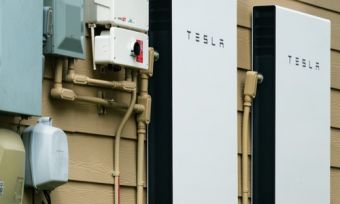Best Solar Feed In Tariff QLD
Looking for a better solar plan or provider in Brisbane? We compare plans and providers that operate in and around the Brisbane area to help you find the best fit for your needs.

Start with your postcode
to compare 1,500+ Canstar Blue expert rated plans
Showing 10 of 67 results
Unsure of a term in the above table? View glossary
The initial results in the table above are sorted by Solar feed-in tariff (High-Low) , then Price/year (estimated) including conditional discount (Low-High) , then Brand Satisfaction (High-Low) . Additional filters may have been applied, which impact the results displayed in the table - filters can be applied or removed at any time.
Latest in solar energy
On this page:
- Which provider has the best solar feed-in tariff in QLD?
- Which is the best solar energy provider?
- How do I know what my solar feed-in tariff is?
- Is there a minimum feed-in tariff in QLD?
- Are solar-specific plans available in QLD?
- Energy rates or solar feed-in tariffs: What’s more important?
- What about solar in regional QLD?
- Is solar worth it in QLD?
Which provider has the best solar feed-in tariff in QLD?
Engie has the best solar feed-in tariff in Queensland at the time of publishing, with a generous 12 cents per kilowatt hour (kWh) on offer to eligible customers for feeding into the grid.
Maximum and minimum solar feed-in tariffs in QLD
In the table below, you’ll find a list of minimum and maximum solar feed-in tariffs available from retailers in Queensland. Some of these companies may not operate in all areas of QLD, while some FiTs may only be available when certain conditions are satisfied. Please check each provider’s website for further details.
Here are the plans with the highest solar feed-in tariffs from the retailers on our database. These costs are based on Energex network in Brisbane but prices will vary depending on your circumstances. We show one product per retailer, listed in order of lowest price first. Annual price estimates assume general energy usage of 4600kWh/year for a residential customer on a single rate tariff. Price estimates exclude solar feed-in tariff credits. These are products from referral partners†. Our database may not cover all deals in your area, and please check retailer websites for up to date information.
Here are the plans with the lowest solar feed-in tariffs from the retailers on our database. These costs are based on Energex network in Brisbane but prices will vary depending on your circumstances. We show one product per retailer, listed in order of lowest price first. Annual price estimates assume general energy usage of 4600kWh/year for a residential customer on a single rate tariff. Price estimates exclude solar feed-in tariff credits. These are products from referral partners†. Our database may not cover all deals in your area, and please check retailer websites for up to date information.
Which is the best solar energy provider?
Red Energy was rated Australia’s best solar energy provider in our annual customer satisfaction ratings in 2024. An Australian-owned company, Red Energy took out a handful of five-star ratings, including FOR customer service, bill and cost clarity, ease of sign-up and overall satisfaction. Red Energy is known for its partnership with Qantas where customers can earn Frequent Flyer points by paying their bills. It has two specific solar plans in the state – Red Solar Saver and Living Energy Solar Saver – which both offer an 8c/kWh feed-in tariff.
How do I know what my solar feed-in tariff is?
If you don’t know what your current feed-in tariff rate is, it should be located on your energy bill. Alternatively, you will find your FiT listed in the relevant energy fact sheet which can be found on your energy retailer’s website. Some power providers are sneakier than others, and may hide this information though it is generally situated at the bottom of the company’s homepage. All retailers must provide fact sheet documents that outline each plan’s rates, fees, charges, along with other important product details.
Is there a minimum solar feed-in tariff in QLD?
In South East Queensland, there is no set minimum solar feed-in tariff that energy retailers have to adhere to. This is why shopping around for a plan with a good FiT is important as power companies will try to compete for your business by offering a more competitive FiT. Don’t forget to check directly with your energy retailer to see if there are promotions or solar-specific deals available, which may not be publicly advertised.
Are there solar-specific plans available in QLD?
Yes, some solar-specific products are on offer in QLD, however these deals are few and far between. Most larger companies, such as AGL and Origin, will generally have solar-specific plans available, but it normally requires certain conditions to be met, such as purchasing solar panels through the energy retailer. It’s a good idea to check the power provider’s website for terms and conditions.
Energy rates or feed-in tariffs: what’s more important?
While a high feed-in tariff can make a world of difference to overall energy costs, it may be suffering at the hands of expensive base rates. The two main costs to look out for are electricity usage rates and supply charges. These rates are billed to customers for the amount of electricity the household uses, along with a fixed daily cost of supplying power to their property via the grid.
Depending on how much electricity a solar system can export, it may be worth calculating which features of an energy plan are best-suited to your needs. For example, if you have a smaller solar system that doesn’t produce much excess electricity to be fed back into the grid, then you may be better off with lower base rates, as opposed to a higher feed-in tariff. On the other hand, if your solar panels export a lot of electricity, then a higher FiT could justify paying increased usage and supply rates. At the end of the day, it’s all about balancing out what works for your circumstances and budget.
What about solar in regional QLD?
Unlike Queenslanders who live in the South East on the Energex network, regional QLD customers on the Ergon Energy network have a minimum feed-in tariff rate of 12.377c/kWh. These rates are set by the Queensland Competition Authority (QCA), a governing body that also monitors retailer’s FiT rates in SEQ.
How to maximise your solar investment in QLD
Maximising your solar investment will come down to choosing an energy provider that offers a good feed-in tariff that best suits your needs. Remember, not all plans are equal, which means it does take some research to find a good deal. Just be sure to scan over the electricity rates of a plan, as well as any other value-add incentives, like discounts, bill credits and rewards programs. With more than 20 retailers across SEQ, there has never been a better time to compare your options.
About our electricity experts
 Tara Donnelly: Utilities Editor
Tara Donnelly: Utilities Editor
As Canstar Blue’s Utilities Editor, Tara Donnelly covers the internet, mobile and energy sectors – topics she’s spent a decade focused on, alongside consumer technology, within the comparison industry. Her telco expertise has seen her appear in national media including 9 News, 7 News, Sunrise, the ABC and The Sydney Morning Herald. You can follow Tara on LinkedIn.
Meet the Editorial Team

Breanna Gream: Data Insights Team Lead
Breanna Gream is Canstar’s Data Insights Team Lead, and is responsible for developing the methodology and delivering Canstar Blue’s Value Ranking for the energy and telco sectors. She holds a dual degree in Business and Mathematics from the Queensland University of Technology, and enjoys using her skills to help consumers find more suitable utilities plans. Connect with Breanna on LinkedIn.
Meet the Research Team
Important information
For those that love the detail
This advice is general and has not taken into account your objectives, financial situation or needs. Consider whether this advice is right for you.




















